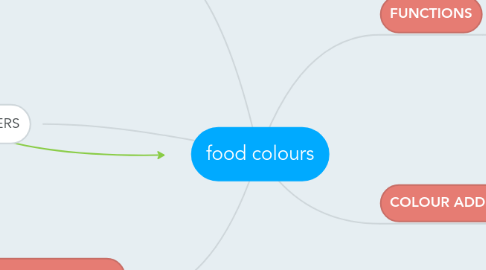
1. NATURAL COLOURS
1.1. ADVANTAGES
1.1.1. most are oil soluble
1.1.2. provide transparent colour to liquid ,oil-based products
1.1.3. has nutraceutical valus
1.2. DISADVANTAGES
1.2.1. inherent instability sensitive to light and heat exposure
1.2.2. not available in blue or green
1.2.3. higher cost of natural materials
2. 2 GROUP OF COLOURS
2.1. NATURAL COLOURS
2.1.1. TURMERIC
2.1.2. PAPRIKA
2.1.3. ANNATTO
2.2. SYNTHETIC COLOURS
2.2.1. FD & C BLUE #1
2.2.2. FD & C GREEN #3
2.2.3. FD & C RED #40
2.2.4. FD & C YELLOW #5
3. COLOUR SUPPLIERS
3.1. WATER SOLUBLE DYES
3.1.1. dyes will dissolves in water and can be manufactured as a powder granule or liquid .often be used in aqueous beverages ,dry mixes confections and dairy prducts
3.2. LAKES
3.2.1. are water soluble FD & C colours ,the base is aluminium hydroxide
4. FUNCTIONS
4.1. encourage acceptance by offsetting colour loss
4.2. correcting natural colour variation
4.3. enhancing naturally weak colour
4.4. provide a colourful identity to products
4.5. supply fun look to kid oriented beverages and candies
5. COLOUR ADDICTIVES
5.1. WHAT IS IT
5.1.1. A colour addictivesis any dye pigment or substances which when added or applied to food,drug or cosmetics ,or to human body is capable (alone or through reactions with other substances ) of imparting colour.
5.2. SEEING IS BELIEVING
5.2.1. unlikely to be eaten unless it has a bright colour
5.2.2. visual perception
5.2.3. not many people will spend money on food that not appealing to eyes
5.2.4. colour entices us to eat
